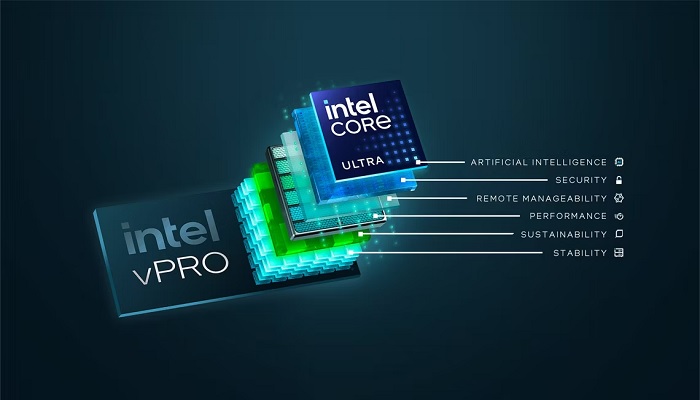
Intel introduced a novel business-class Ultra mobile processor lineup alongside vPro support for its 14th-gen desktop chips at Mobile World Congress, emphasising advancements in AI-driven performance.
The new vPro platform, featuring integrated Intel Arc GPUs on Ultra mobile chips, neural processing units (NPUs), and compatibility with familiar Intel CPUs, offers a comprehensive solution capable of handling demanding applications efficiently. Collaborating closely with Microsoft, Intel anticipates the deployment of around a hundred business devices equipped with these new vPro processors, all running on Windows 11.
While Intel vPro technology has been in existence for some time, the introduction of these new SKUs and support for 14th-gen desktop chips brings significant performance enhancements, improved power efficiency, and the integration of Intel Arc Pro graphics.
Read more: Best laptops in 2024
With a combination of CPU, NPU, and GPU within the same package, these Raptor Lake Refresh desktop chips and Intel Core Ultra mobile processors empower business devices to support modern applications effectively, unlocking enhanced performance and AI-driven experiences. Although Intel isn't formally launching new 14th-gen processors for vPro, the functionalities provided through this platform can be activated by using a Q670 or W680 motherboard.
Moreover, Intel is collaborating with OEMs to enable a specialised Arc Pro workstation graphics driver, ensuring optimised performance in creative, design, and engineering software. Leveraging Intel's recent hybrid processor architecture, the new Core Ultra processors promise both robust performance for intensive workloads and efficiency during periods of lower demand, incorporating two additional low-power efficiency cores per SKU.
Intel emphasises various features of its latest vPro platform, including heightened productivity, with reported office application performance boosts of up to 47% compared to three-year-old PCs running on 11th-gen Intel Core i7 1185G processors.
The inclusion of Intel Threat Detection Technology enhances anomaly detection efficiency, particularly crucial for mobile devices reliant on internal power supplies. Additionally, Intel's Silicon Security Engine enhances system firmware authentication, bolstering security against threats below the OS layer.
These advancements not only deliver significant performance improvements over previous generations but also align with Intel's sustainability initiatives, with 94% of Intel vPro-powered devices rated EPEAT Silver or better, enabling businesses to reduce their environmental footprint by opting for more eco-friendly desktop and laptop PCs.
Intel's focus on AI computing represents a strategic move towards redefining the role of personal computers in business operations. By integrating AI capabilities into its processors, Intel aims to facilitate over 300 AI-accelerated features, enhancing productivity and efficiency.
Collaborations with Microsoft and other software developers indicate a concerted effort to embed AI functionality into operating systems and business applications, ensuring seamless integration and optimal performance.
Furthermore, similar to how APUs combine discrete graphics and processor functions, Intel vPro processors leverage powerful graphics processing to address heavier workloads traditionally requiring dedicated GPUs.
With rising expectations for graphics performance in both consumer and professional settings, these vPro processors offer ray tracing capabilities and AI upscale support for 8K video, catering to evolving user demands.
As Intel and Microsoft embark on this next phase of computing, deeper integration between hardware and software is anticipated, promising a seamless user experience and enhanced productivity across various business applications and workflows.
















